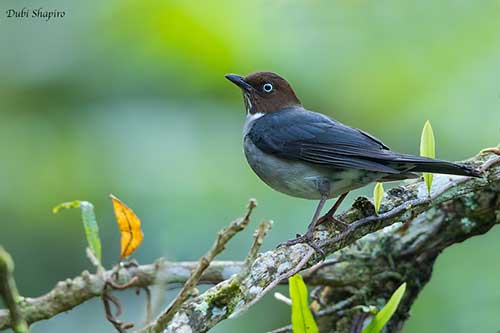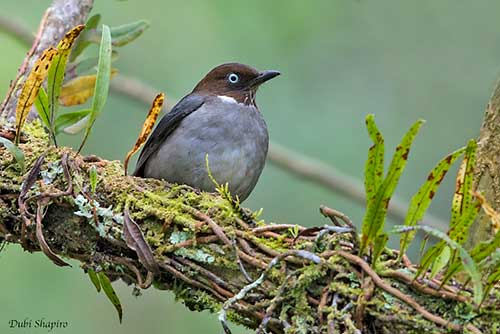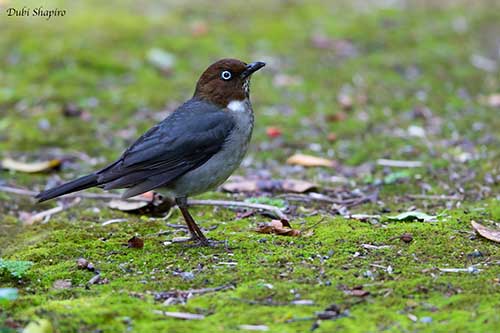
REPRODUCTION OF THIS SPECIES:
The White-eyed Thrush breeds between April and June.
The bulky nest is made with plant material and placed in small tree.
The female lays 2-3 pale bluish-green eggs with dense dark speckling.
PROTECTION / THREATS / STATUS:
The White-eyed Thrush has restricted range in Jamaica where it is fairly common in mountains. It is present in Blue Mountain and John Crow National Park.
This species is vulnerable to degradation and destruction of the habitat, but it is not globally threatened.
The White-eyed Thrush is currently evaluated as Least Concern.
Fr: Merle aux yeux blancs
Ang: White-eyed Thrush
All: Weißaugendrossel
Esp: Zorzal Jamaicano
Ita: Tordo occhibianchi
Nd: Witooglijster
Sd: vitögd trast
Photographer:
Dubi Shapiro
Dubi Shapiro Photo Galleries & Dubi Shapiro's Pictures on IBC
Text by Nicole Bouglouan
Sources:
HANDBOOK OF THE BIRDS OF THE WORLD Vol 10 by Josep del Hoyo-Andrew Elliott-David Christie - Lynx Edicions - ISBN: 8487334725
THRUSHES by Peter Clement and Ren Hathway – HELM - ISBN: 0713639407
BIRDS OF THE WEST INDIES – by Herbert Raffaele, Kristin Williams et Tracy Pedersen – Helm – ISBN: 9780713649055
A Photographic Guide to the Birds of Jamaica by Ann Haynes-Sutton, Yves-Jacques Rey-Millet, Audrey Downer, Robert Sutton – Editor: Bloomsbury Publishing, 2010. ISBN: 1408133229, 9781408133224 - 336 pages
White-eyed Thrush
Turdus jamaicensis
Passeriformes Order – Turdidae Family
INTRODUCTION:
The White-eyed Thrush is endemic to Jamaica where it frequents montane and lowland forests, but also heavily degraded former forest. This species is fairly common in mountains.
It typically feeds on fruit and invertebrates found among the dense vegetation, from the forest floor to the canopy.
The White-eyed Thrush is vulnerable to degradation and destruction of the habitat involving decline of the population. But the species is not currently threatened.
DESCRIPTION OF THE BIRD:
Biometrics:
Length: 23-24 cm
Weight: 59-60 g

The White-eyed Thrush has dark grey upperparts from mantle to tail, and pale grey to greyish-brown underparts. Chin and throat are whitish with brown streaks, except for a white crescent on the upper breast. The vent is white.
The head is chestnut-brown.
Bill, legs and feet are black. The eyes are white, sometimes varying to pale bluish-white. This species is locally known as “glass-eye”.
Male and female are similar.
The juvenile resembles adult, but with heavy streaking on breast.
RANGE:
The White-eyed Thrush is endemic to Jamaica where it occurs mainly in mountains.
HABITAT:
The White-eyed Thrush frequents wet mountain forests and wooded hills, from 100 metres of elevation to the highest peaks. It can be seen in gullies and ravines, and also frequents coffee plantations and other woodlands at mid-elevations.
CALLS AND SONGS: SOUNDS BY XENO-CANTO
The White-eyed Thrush gives a shrill, harsh “dzeee” or “dzaw” note also used as alarm call.
It has varied, musical song with each phrase repeated 2-3 times. The song starts with a high-pitched but descending “seeooo… seeooo… seeooo…” and also includes trilling whistles and harsher notes, with a repeated bell-like whistle “hee-haw”.

BEHAVIOUR IN THE WILD:
The White-eyed Thrush feeds primarily on fruit such as berries and small figs. It also consumes invertebrates including earthworms and insects.
It forages in dense vegetation, from the forest floor in the leaf litter, to the canopy of the forest. It is shy and secretive, and occurs mainly in the dark areas of the forest.
The White-eyed Thrush breeds from April to June, but the breeding behaviour is currently unknown.
This species is resident in Jamaica. The birds breeding at high elevations move to lower levels during the non-breeding period, although the species is rare in lowlands and valleys.
The White-eyed Thrush flies low through the trees, but the flight is swift.
